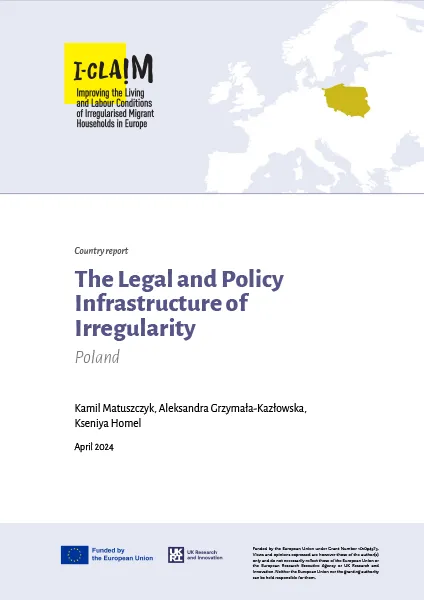The Legal and Policy Infrastructure of Irregularity: Poland
Matuszczyk, Kamil; Grzymala-Kazlowska, Aleksandra; Homel, Kseniya
How to cite:
Matuszczyk, K., Grzymala-Kazlowska, A., Homel, K. (2024) The legal and policy infrastructure of irregularity: Poland. I-CLAIM. DOI: https://zenodo.org/records/11094089
The Legal and Policy Infrastructure of Irregularity: Poland
Matuszczyk, Kamil; Grzymala-Kazlowska, Aleksandra; Homel, Kseniya
Embedded within the conceptual framework of ‘irregularity assemblage’, this report focuses on ‘the production of irregularities’ in the context of migration, aiming to illuminate its complexity from the perspective of the national policy level in Poland. Drawing on our qualitative empirical material and secondary data, this report explains the complexity of the phenomenon of irregularised migrants and irregular migration to Poland between 2004 and 2023. Although the attractiveness of immigration to Poland has increased in recent years, channels of irregular immigration (mainly from post-communist countries or Vietnam) were already observed in the 2000s. The government’s response to this new challenge was to launch three regularisation campaigns in 2003, 2007, and 2012, which involved only a few thousand people. The estimated number of irregular migrants in Poland around 2016 was less than 100,000, with more precise figures for 2019 suggesting a decrease to 15,000-20,000 people. Importantly, in refugee migration, Poland has never been a leading destination country; instead, it has been treated as a transit country. This was encouraged, among other things, by a rather hostile policy to refugees and migrants from outside the Christian cultural sphere. A turning point in the discussion of irregular migration was the refugee crisis on the Polish-Belarusian border, which has continued to dominate political and media discourse since mid-2021.
Apart from the regularisation measures, successive governments have not introduced separate solutions concerning irregularised migrants. Foreigners without the necessary residence permits have significantly limited access to public services or social assistance. The lack of an overall vision of immigration and integration policy results in numerous difficulties for foreigners living in Poland. The study also highlights the problem of racialisation and ethnicisation in political discourse, legislation, and the practices of public institutions. Moreover, the study has found that the provisions of the immigration laws remain unclear, administrative procedures take much longer than the law requires, and there is a shortage of qualified staff in public institutions dealing with foreigners. What is more, foreigners residing in Poland can fall into the trap of irregularity relatively quickly (and unknowingly).
The main area of political or academic discussion in relation to undocumented migration remains the presence and activity of foreigners in the labour market. The evidence presented in this report confirms the existence of labour market niches in which conditions favour work in the informal economy (e.g., agriculture, domestic work). Despite the introduction of numerous measures to liberalise access to the labour market in Poland since 2006, examples of illegal employment of foreigners can still be observed. Immigrants from Ukraine, who can count on privileged treatment, remain the dominant group of foreign workers in Poland. This is facilitated, among other things, by the special law introduced in March 2022, which is dedicated to displaced people fleeing the full-scale Russian aggression in Ukraine. At the same time, recent years have seen a growing presence of workers from Asian or South American countries, who are often victims of the unfair practices of employers or migration intermediaries.
